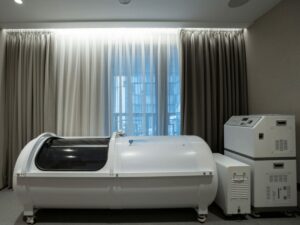Can hyperbaric oxygen therapy contribute to a longer and better quality of life? Research and clinical evidence suggest a resounding yes.
Drawing from extensive research and practical experience in hyperbaric technology, my analysis offers a unique perspective on HBOT’s benefits.
In this article, we will delve into the mechanisms by which hyperbaric oxygen therapy enhances bodily functions, and its potential to improve longevity and quality of life.
Discover the groundbreaking benefits of HBOT!
1. The Role of HBOT in Age-Related Diseases
Hyperbaric oxygen therapy (HBOT) is the treatment of age-related diseases by significantly increasing the body’s tissue oxygen levels. This method effectively addresses symptoms associated with aging, such as complications from diabetes, stroke, and cognitive decline, by enhancing oxygen availability to tissues.
The potential of HBOT to not only manage but also potentially reverse certain effects of age-related diseases is generating considerable interest. According to Precedence Research, the global oxygen therapy market, which includes HBOT, is expected to grow at a compound annual growth rate (CAGR) of 5.38% from 2023 to 2032, highlighting its increasing importance in the medical field.
2. Potential Medical Benefits of HBOT
Following our exploration of HBOT’s role in tackling age-related diseases, it’s clear this therapy has much more to offer. Here are the key benefits that stand out:
Enhanced Wound Healing
HBOT has shown remarkable efficacy in speeding up the healing process of wounds, particularly those that are stubborn or chronic. By delivering a higher concentration of oxygen to the wound site, it not only accelerates tissue repair but also reduces the risk of infection. This is a game-changer for healthcare providers focusing on wound care and post-operative recovery.
Improved Recovery from Sports Injuries
Athletic teams and sports facilities should take note that HBOT can significantly shorten recovery times for athletes. Whether it’s a sprained ankle or a more severe injury, the therapy boosts oxygen levels in the blood, helping to reduce swelling and promote healing. Athletes can return to their peak performance levels faster, making this therapy a valuable tool in sports medicine.
Enhanced Cognitive Function
HBOT has the potential to improve cognitive functions, offering hope in the fight against neurodegenerative diseases. For instance, by increasing oxygen supply to the brain, it can enhance neuroplasticity, which is crucial for memory, learning, and overall brain health. For medical facilities specializing in neurological care, incorporating HBOT could be a significant step forward in patient treatment.
Support in Combatting Infections
HBOT is a powerful ally in the battle against certain types of infections. By bolstering the body’s oxygen levels, it strengthens the immune system’s ability to fight off bacteria, including those resistant to antibiotics. This aspect of HBOT is particularly relevant for hospitals and clinics dealing with complex, hard-to-treat infections, offering a complementary approach to traditional therapies.

3. HBOT and Its Current Medical Applications
After highlighting the substantial benefits of hyperbaric oxygen therapy, it’s fascinating to delve into its current applications in the medical field. Here are the primary areas where HBOT is making a difference:
Treatment of Diabetic Foot Ulcers
Diabetic foot ulcers represent a significant challenge in healthcare, often leading to severe complications if not treated effectively. HBOT comes into play by enhancing oxygenation, thereby accelerating wound healing and reducing the risk of amputation. This therapy has become a cornerstone in the management of diabetic foot ulcers, offering patients a chance for not just recovery, but a return to normalcy.
Management of Radiation Injuries
Radiation injuries can be a distressing side effect of cancer treatment, impacting quality of life significantly. HBOT provides a breath of fresh air here, by promoting healing in damaged tissues and bones. Clinics specializing in oncology and post-radiation care are increasingly incorporating HBOT, witnessing firsthand its capacity to alleviate pain and foster healing.
Aid in Recovery from Brain Injuries
The brain’s ability to recover from injury is nothing short of amazing, and HBOT is proving to be a valuable tool in this process. By increasing oxygen supply to the brain, it supports the repair of brain tissue and helps improve functions affected by trauma or stroke. For rehabilitation centers and neurology departments, HBOT opens up new possibilities for patient recovery and rehabilitation.

4. The Process of Undergoing Hyperbaric Oxygen Therapy
With the expanding applications of hyperbaric oxygen therapy in the medical field, I know you will agree that many are curious about what the process involves. Here’s a step-by-step breakdown:
Step#1 Initial Consultation and Evaluation
Before starting therapy, patients undergo a comprehensive evaluation to assess their suitability for HBOT. This typically involves reviewing medical history, current health status, and the specific condition being treated. It’s a crucial step to ensure that HBOT is both safe and likely to be beneficial for the patient.
Step#2 Preparation for Therapy
Once cleared for HBOT, patients are prepared for what to expect during the sessions. This preparation includes guidelines on clothing to wear (usually cotton) and items to avoid bringing into the chamber, such as lighters or electronic devices. It’s all about making sure everything goes smoothly and safely.
Step#3 Entering the Hyperbaric Chamber
The next step is entering the hyperbaric chamber, which can be a single-person unit or a larger room that accommodates multiple patients. Once inside, the chamber is sealed, and the pressure gradually increases, filling the chamber with pure oxygen. Patients can relax, sleep, or listen to music during this time.
Step#4 Undergoing the Therapy
During the session, patients breathe pure oxygen under increased pressure, which allows for a greater absorption of oxygen by the body’s tissues. Sessions typically last between 60 to 90 minutes, depending on the condition being treated and the specific protocol followed. It’s a painless process where patients often feel only a slight pressure in their ears, similar to what one might experience during an airplane ascent or descent.
Step#5 Post-Therapy Monitoring and Follow-up
After the session, patients are monitored for any immediate reactions to the therapy. Follow-up assessments are also important to evaluate the therapy’s effectiveness and adjust the treatment plan as necessary. The number of sessions required varies, but improvements are often observed after the first few treatments.
Here’s a table detailing the critical aspects of post-therapy monitoring and follow-up in hyperbaric oxygen therapy:
| Step |
Description |
Benefit |
| Adjustment of Treatment Plan |
Treatment plans may be modified based on the patient’s response to the therapy. |
Tailors the therapy to the patient’s specific health needs, optimizing outcomes. |
| Documentation of Progress |
Continuous recording of therapy sessions and patient responses. |
Provides a detailed history that can inform future treatment decisions and continuity of care. |
| Long-Term Monitoring |
Long-term assessment to evaluate the therapy’s impact on overall health and quality of life. |
Helps in understanding the long-term benefits and any potential ongoing needs of the patient. |
5. Potential Risks and Side Effects of HBOT
After detailing the HBOT process, it’s essential to consider the safety aspects. Here are the potential risks and side effects:
Ear and Sinus Pressure
One common side effect of HBOT is discomfort or pain in the ears and sinuses caused by the changes in pressure. This is similar to what you might feel in an airplane. Techniques such as yawning or swallowing can help alleviate this discomfort. It’s important for patients to communicate any discomfort during the session so adjustments can be made.

Oxygen Toxicity
While rare, oxygen toxicity is a potential risk of HBOT. This occurs when there’s too much oxygen in the body, leading to symptoms like nausea, twitching, or dizziness. Monitoring oxygen levels and adhering to recommended treatment protocols minimizes this risk, ensuring a safe therapy experience.
Vision Changes
Some patients experience temporary vision changes, such as farsightedness, which typically resolves after completing the therapy sessions. This side effect is due to oxygen’s effect on lens shape and eye pressure. Informing patients about this possibility prepares them for any temporary adjustments they might need to make in their daily lives.

6. HBOT vs. Traditional Longevity Methods
After exploring the potential risks and side effects of HBOT, it’s intriguing to see how it stacks up against more traditional methods aimed at enhancing longevity. Here are the key comparisons:
Efficiency in Treatment
HBOT introduces a high concentration of oxygen into the body’s tissues, a direct approach that is not matched by traditional methods. For instance, traditional practices, such as diet and exercise, are essential for overall health but may not deliver as immediate or targeted effects in treating specific conditions. At Oxygen-ark, we recognize HBOT’s ability to rapidly accelerate healing and improve cellular function is a significant advantage.
Scope of Application
Traditional longevity methods often focus on prevention and maintenance, which are undoubtedly vital. However, HBOT extends beyond prevention, offering therapeutic benefits for existing conditions, including serious age-related diseases. This therapy is unique in its ability to not only support general well-being but also to actively combat and reverse damage from a variety of health issues.
Technological Advancement and Innovation
HBOT represents a leap in medical technology, leveraging the latest scientific findings to enhance health and longevity. Traditional methods, while effective, rely on principles that have remained largely unchanged over time. HBOT, on the other hand, is a testament to the progress in medical science, offering a modern approach that can be continuously refined and improved with ongoing research.
7. 3 Practical Considerations for Those Interested in HBOT
Having compared HBOT with traditional longevity methods, it’s clear that HBOT offers unique benefits. Here are some practical considerations for organizations looking to integrate HBOT services:
#1 Facility Specification of 150+ Square Feet
Facilities must allocate at least 150 square feet for each hyperbaric chamber to accommodate the necessary equipment and ensure safe operation. This space should also support the specific environmental controls required for handling 100% oxygen, in compliance with NFPA 99 standards for fire safety and ventilation.
#2 40 Hours of Specialized Training
Staff operating hyperbaric chambers must undergo specialized training, which typically encompasses at least 40 hours of instruction on hyperbaric medicine, safety protocols, and chamber maintenance. Oxygen-ark suggests that obtaining certification from bodies such as the Undersea and Hyperbaric Medical Society (UHMS) ensures the highest standards of care and compliance.
#3 NFPA 99 Compliance
Adhering to the National Fire Protection Association (NFPA) 99 Health Care Facilities Code is non-negotiable for HBOT facilities. This comprehensive guideline covers essential safety measures, including fire safety and operational protocols, to protect patients and staff. Facilities must conduct regular safety audits and equipment checks to maintain compliance.
Dive Deeper Into Our Resources
Looking for more diverse product options? Browse through our handpicked selections:
Still haven’t found what you’re looking for? Don’t hesitate to contact us. We’re available around the clock to assist you.
Conclusion
Hyperbaric oxygen therapy (HBOT) stands out as a significant advancement in medical technology with the capacity to markedly improve life expectancy and quality of life. By enhancing oxygen delivery to tissues, HBOT supports healing, boosts immune function, and potentially slows aging processes.
For organizations looking to integrate this cutting-edge therapy into their offerings, Oxygen-ark provides solutions that meet high standards. Contact us today to learn more about our offerings.




